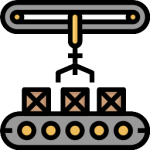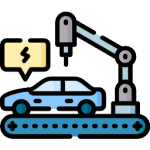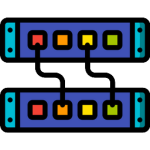Robotics, Automation and Installations
Electrical installations, mechanical assembly, commissioning, service and maintenance, automation.
Scope of Mechanical and Electrical Onsite Installations.
Mechanical Installations
Mechanical installation services include the setup and alignment of heavy equipment, piping systems, conveyor belts, and structural components. The focus is on precision alignment, secure anchoring, and system integrity to ensure optimal performance and safety. Technicians handle tasks such as welding, bolting, and fitting to meet exact design specifications.Electrical Installations
Electrical services cover the installation of power distribution systems, control panels, lighting, motor drives, and wiring for factory equipment. This involves connecting electrical systems to power sources, calibrating control systems, and integrating automation solutions for efficient factory operations. Attention is given to grounding, insulation, and compliance with electrical safety standards.
Key Processes in Onsite Installations
- Site Preparation: A thorough evaluation of the site to ensure readiness for installations, including verifying foundations, access points, and environmental conditions.
- Unloading and Positioning: Safe transportation and precise positioning of mechanical and electrical components using cranes, forklifts, and rigging equipment.
- Assembly and Integration: Aligning and connecting mechanical systems, piping, and electrical components to create a cohesive operational setup.
- Testing and Calibration: Conducting performance tests on mechanical and electrical systems, ensuring they meet operational and safety specifications.
- Commissioning: Finalizing installations and certifying that all systems are ready for full-scale operation.
Benefits of Professional Onsite installations
- Efficiency: Ensures systems are installed quickly and accurately to reduce downtime.
- Safety: Professional teams adhere to strict safety protocols to protect personnel and equipment.
- Compliance: Installations meet industry standards and regulatory requirements.
- Customization: Tailored solutions that address specific site and operational needs.

Cable Pulling
Cable pulling in onsite factory installations is the process of laying and routing electrical cables to connect power and communication systems within a facility. This involves carefully pulling cables through conduits, trays, or underground pathways, ensuring they are securely positioned without damage. Proper cable pulling requires specialized tools, such as winches and rollers, as well as expertise to prevent tension, bending, or insulation damage. It is a critical step in ensuring reliable electrical connections, system efficiency, and adherence to safety and regulatory standards.

Electrical installations
Electrical installations in onsite factory setups involve the planning, wiring, and integration of power and control systems to support the facility's operations. This includes installing power distribution panels, transformers, lighting systems, machinery connections, and control panels. The process ensures that all electrical components are safely and efficiently connected, adhering to industry standards and safety regulations. Proper electrical installations are crucial for reliable energy supply, equipment functionality, and overall operational efficiency in the factory.

Industrial electrical installations
Industrial electrical installations in onsite factory setups involve the design, wiring, and commissioning of robust electrical systems to power heavy machinery and critical operations. This includes installing transformers, power distribution systems, motor controls, automation panels, and industrial lighting. These installations are tailored to handle high power loads, ensuring efficiency, safety, and compliance with industrial standards. Proper execution of industrial electrical installations is essential for optimizing factory performance and minimizing downtime.

Mechanical assembly
Mechanical assembly in onsite factory installations involves assembling, aligning, and securing mechanical components such as machinery, conveyors, pumps, and structural supports. This process ensures that all equipment is installed accurately and operates seamlessly as part of the factory's production system. It includes tasks like bolting, welding, precision alignment, and testing to guarantee functionality and durability. Proper mechanical assembly is essential for reliable performance, safety, and efficiency in industrial operations.

Production line installation
Production line installation in onsite factory setups involves assembling and integrating machinery, conveyors, robotics, and control systems to create a seamless manufacturing process. This includes positioning equipment, aligning components, connecting utilities, and testing for operational efficiency. The installation ensures that the production line meets design specifications, operates safely, and maximizes productivity. Proper production line installation is critical for achieving optimal workflow, reducing downtime, and supporting high-quality output in industrial operations.

Switchboard assembly
Switchboard assembly in onsite factory installations involves assembling and installing electrical switchboards that manage power distribution and control within the facility. This includes mounting circuit breakers, busbars, switches, and protective devices, ensuring proper wiring and connections. The process ensures that the switchboard complies with safety standards and can handle the factory's power requirements efficiently. Proper assembly is crucial for reliable power management, system safety, and operational continuity.

Testing electrical installations
Testing electrical installations is a crucial process to ensure the safety, reliability, and efficiency of electrical systems. It involves inspecting wiring, connections, and components, as well as conducting performance tests such as insulation resistance, continuity, and load testing. These checks verify compliance with safety standards and identify potential issues before system activation. Proper testing ensures that the electrical installation operates correctly, minimizing risks of failure, downtime, or hazards.
Robotics, Automation and Installations, Robotics, Automation and Installations,
